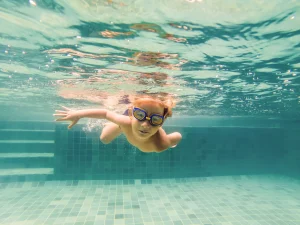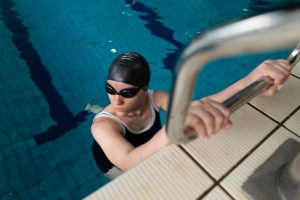Swimming is one of the most complete and enjoyable physical activities, especially for children. However, swimming safety goes far beyond simply knowing how to swim. Being in contact with water requires technique, respect, attention, and prevention.
Did you know that approximately 47% of child drowning deaths occur in places such as swimming pools, lakes, rivers, and even bathtubs? This alarming figure, provided by the National Child Mortality Database, reinforces the importance of aquatic education from the earliest years of life, even in settings that appear safe, such as the family home.
That is why, more than just learning to swim, it is essential to apply the safety concepts taught in lessons to different situations.
Lessons from Classes to Reinforce Swimming Safety at Home
Having a home pool is synonymous with leisure, fun, and family time. But it can also pose risks, especially for young children.
Familiarity with the home environment may create a false sense of security and lead to neglecting essential care.
In swimming lessons, children learn that water, even in controlled settings, always demands respect. This learning is reflected in practical behaviours that should be applied daily, such as:
- Entering and exiting the pool carefully, using ladders or appropriate edges;
- Avoiding running around the pool, reducing the risk of slips and falls;
- Respecting personal limits and not attempting dives or manoeuvres beyond one’s capacity;
- Learning signals and keywords for help, making communication easier in emergencies;
- Never swimming alone or without supervision, especially for children;
- Avoiding contact with drains or suction devices that could trap hair or clothing.
In addition, it is essential to adopt physical barriers for protection, such as fences around the pool, safety covers, and removing toys from the water after use. These preventive actions can save lives.
Taking Lessons to Beaches, Rivers, and Lakes
Beyond the home pool, the lessons learned are also valuable in settings such as beaches, rivers, and lakes, where risks are even more unpredictable.

Currents, holes, strong waves, tide changes, and even the presence of aquatic animals are challenges that demand extra caution.
Fortunately, swimming lessons also address these scenarios, even if not all pupils visit such environments regularly. The important thing is to develop a safety mindset.
Some valuable lessons to apply outside the home are:
- Stay calm in case of a current. Instead of fighting it, swim sideways until you can escape;
- Avoid swimming in places marked as dangerous, with warning signs or murky waters;
- Always prefer swimming with lifeguard supervision or a prepared adult;
- Wear life jackets on boats or during aquatic activities, especially for children and those who are not strong swimmers;
- Pay attention to changing weather conditions, which can alter safety in just minutes.
Even good swimmers can become tired, suffer cramps, or become disoriented in open water. That is why respect for the natural environment must be cultivated from childhood.
How to Prevent Water Accidents?
Knowing how to swim is fundamental, but it is not enough. Preventing accidents goes beyond technique: it involves emotional preparation, risk awareness, and training for real situations.
Easy2Swim instructors include rescue and self-rescue simulations in their lessons to prepare both children and adults for real aquatic situations.
When lessons are held at home, it is advisable for the whole family to take part in the learning, understanding which practices reduce risks.
Want to picture it more clearly? Imagine a child who slips and falls into the pool but recalls the teachings from lessons. Instead of panicking, they float on their back, breathe calmly, and move to the edge where they can exit safely.
This reaction is only possible thanks to repetition and preparation provided by practical self-rescue lessons.
Essential Equipment for Swimming Safety at Home
Beyond the equipment used in lessons, such as floats, noodles, and kickboards, other important items for safety at home include:
- A rescue buoy near the pool;
- A telephone nearby for emergency calls;
- Basic knowledge of first aid and CPR (cardiopulmonary resuscitation).
You can ask a qualified professional to teach these techniques to the whole family, expanding the safety network.
It is also essential to talk with children about their personal limits. Even if they feel confident, they must respect rules, recognise dangers, and know how to ask for help.
Encourage these conversations in a light-hearted way, with educational games, reinforcing what is taught in lessons.
Safety in and out of the Pool Begins with Education
Safety starts in lessons, but it is strengthened in everyday life, in every moment spent near water. With technique, prevention, and awareness, swimmers become better prepared and more protected, whether swimming at home, at the club, or in nature.

Lessons turn aquatic leisure into a positive and safe experience for the whole family.
That is why you should ensure swimming safety at home with personalised lessons from Easy2Swim. Book your private class now and see how our instructors respect each student’s pace, profile, and goals – from the first float to essential self-rescue skills.






